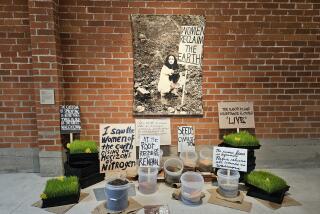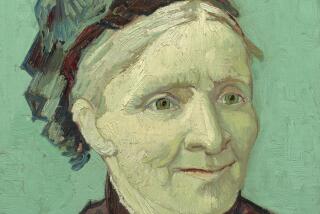AROUND THE GALLERIES
- Share via
Zadok Ben David’s breathtaking “Blackfield” installation at Shoshana Wayne Gallery hinges on dualities that are by nature reductive and simplified; the work’s visceral power redeems it from lapsing into the simplistic. It is an emblematic landscape of extremes that presents a graphically stunning opposition between the Edenic and the ashen, promise and aftermath -- and ultimately life and death.
The dark vision comes first. Entering the huge main gallery, you see an expansive 36-by-29-foot, cleanly edged field of fine, pale sand. Sprouting from this shallow ground are more than 12,000 small, paper-thin, precisely crafted plants, more or less evenly dispersed across the vast spread. The plants, derived from Victorian botanical illustrations and textbooks, are photo-etched on steel and painted black. As tiny as a 1/2 -inch tall up to roughly 8 inches, the array of blossoms, sprigs and thistles all face forward in a striking fusion of two- and three-dimensional space, at once austere and spectacular.
As you walk around the perimeter of the piece, the duality reveals itself. The reverse side of each plant is painted in vibrant, even garish color -- amped-up lime, cherry, grape -- as unnaturally vivid as the flip sides are unnaturally stark. The juicy vitality of the view from this angle contrasts utterly with the other’s desiccated severity. Suddenly, we are part of a Technicolor garden, where moments before we stood in a cemetery.
The installation compels movement down and around. Crouching, you can better discern the delicacy of the individual plant images, even as the view outward, across the expanse, grows denser. From midpoints along the sides of the installation, your vision can sweep across the varied crop and take in simultaneously the twinned faces. From any angle it’s easy to appreciate the theatrical artifice of the entire assembly of little cutout props.
By so dramatically scaling down the plants, Ben David scales up our own presence and sense of power. Looking down upon the landscape with a god’s-eye perspective, we are invested, symbolically, with godlike control, the potential to create or destroy, revere or dismiss. Viewing “Blackfield,” as I did, on Earth Day made its stewardship message all the more pronounced.
Admittedly, the distilled polarity of the piece verges on gimmickry, but its sheer optical splendor is irresistible. The same can’t be said of a group of Ben David’s smaller works in the side gallery. Though the same technical methods are at play, the effects are radically diminished.
Three plexi boxes with mirrored backs, wall-mounted at eye level, look like maquettes for the installation and feel like diluted versions of it. Each contains a few dozen of the steel cutout plants, black on one side, colored on the other, with the heavy-handed addition of a silvery shadow at the base of each stem.
In four other boxes, Ben David has mounted a single black, stainless-steel disk representing a tight close-up of a silhouetted, leafless tree. The images, whether read as moons, suns, earths or simply prescribed views, are vaguely lyrical but burdened too by the cheap illusionism of those little shadows or reflections at their base.
Reproductions of work from throughout the artist’s 30-year career show him to be regularly susceptible to the graphically grabby one-liner. What makes “Blackfield,” Ben David’s first solo venture in L.A., so indelible is its engagement with the body on the dual scales of the miniature and the gigantic, the way it harnesses the power of the small, multiplied.
Antony Gormley (from London, where Ben David has lived since the 1970s) employs a similar force in his “Fields” of thousands of small terra cotta humanoid figures with gaping holes for eyes. Others too, including Do-Ho Suh and Chris Burden (especially his military-themed installation of 50,000 nickels, each mounted with a matchstick) have exploited that power for disparate ends. Ben David’s wondrous installation makes us feel larger than we are but exactly as responsible as we need to be, to choose between miracle and catastrophe.
--
Shoshana Wayne Gallery, Bergamot Station, 2525 Michigan Ave., Santa Monica, (310) 453-7535, through May 16. Closed Sundays and Mondays. www.shoshanawayne.com
--
Compelling
odds and ends
Jedediah Caesar is a fascinating cross between sausage-maker and archaeologist of the present, Minimalist and materialist. He throws all kinds of odds and ends (bits of wood, fiber, plastic, metal, plant stems, shells, studio scraps) into boxes or crates, pours in resin (clear or colored), cuts the resulting hardened blocks into slices, then mounts the cross-sections (recalling Carl Andre’s squares and also Constructivist designs) on the wall like checkerboard tiles or in vertical stacks.
In his show at Susanne Vielmetter Los Angeles Projects, larger pieces lean against the wall like John McCracken planks. The surfaces dance with itchy lines and furry clots. The translucent resins gleam with quartz-like purity; the more opaque ones provide industrial-strength filler.
Caesar, based in L.A., exhibits work that represents different phases of his process, including large unaltered accretions of objects (rusted chair frames, shredded tires, tumbleweeds) and recycled portions of earlier, exhibited work. One unsawed box has a foamy head the color of orange sherbet, clotted with random debris.
Time is not a neutral background to Caesar’s work but an active force within it, turning mundane fragments into fossilized artifacts. The found and the made, the serendipitous and the intentional, jostle each other throughout. The most compelling pieces are those in which neither impulse dominates but in which chance and control reach a tenuous equilibrium. The abject flirts with beauty, and the tone is rollicking, rough and raw.
--
Susanne Vielmetter Los Angeles Projects, 5795 W. Washington Blvd., Culver City, (323) 933-2117, through May 23. Closed Sundays and Mondays. www.vielmetter.com
--
Mildly irreverent clay sculptures
A giraffe with bulbous breasts for eyes. A full-size banana rising from the fly of a miniature cowboy’s pants. A man with an impossibly tall, multi-patty hamburger where his head should be. Such ridiculous conflations abound in Tetsuji Aono’s new sculptures at L2kontemporary. Beautifully crafted pop-culture pastiches, they evoke a smile but little more -- neither deep guffaw nor pensive pause.
Aono works in clay, and the group of unglazed pieces that forms the centerpiece of the show are crisply executed, as formally smart as they are conceptually silly. Ranging from 18 to 25 inches in height, each features one or two figures standing on what appears to be an oval jewelry box. Heads and other body parts are mix-and-match, but what remain consistent are the elegant eggshell surfaces, many of them perforated all over with holes of various sizes, like polka-dot voids.
In several other pieces that combine glazed and unglazed surfaces, the L.A. artist stacks his forms, totem style, into unified monuments to incongruous un-monumentality.
Kitschy figurines of a bunny, a gingham-skirted woman and a cliched Indian girl with feather headdress pile neatly atop geodesic spheres and decorative bases. In one 6-foot-tall totem, teddy bear forms are stacked head to head and toe to toe, all of them punched with holes and largely unglazed but for the uppermost bear, its skin an uninterrupted, gleaming graphite.
Aono bastardizes decorative collectibles, but his irreverence carries little heft because he doesn’t take on images or forms that are particularly sacred. He samples and remixes, and the sentimental, sexual, comical and trite ally with ease, when unease might leave a stronger impression.
--
L2kontemporary, 990 N. Hill St., No. 205, L.A., (626) 319-3661, through May 16. Closed Sundays through Wednesdays. www.l2kontemporary.com
--
A trio show with no weak links
The works that make up “3 Solo Projects” at Ben Maltz Gallery are clever showpieces of aesthetic resourcefulness that exploit the tension between synthetic and natural. Together, they make for a variably engaging show that could be subtitled “The Haunting, the Daunting and the Whimsical.”
Jessica Rath’s “Tree Peel” is the show’s visceral powerhouse. A cast of a dying tree, made of latex, cheesecloth, rubber, cotton, wire and steel, the piece reads as an unnervingly beautiful, vaguely toxic version of a leafless tree, with beefy, twisting trunk and numerous dead-end branches. A cousin to trees created or re-created by Roxy Paine and Zoe Leonard, Rath’s stands as a gorgeous lament. Its acrid yellow skin is rough and webby, studded with chips of actual bark. The surface is a textural tempest, echoing Expressionist painterly muscularity as well as the frothy, Turner-esque sublime. “Tree Peel” oscillates profoundly between the noble and the grotesque.
Carrie Ungerman’s shimmering dreamscape, “silverflow,” sugarcoats a heap of trash. Miles of Mylar ribbon (from a few inches to more than a foot wide) drape, wrap and drizzle over bundles of used plastic water bottles. The piles rise like trees or mountain peaks, some to the full height of the gallery. With liquid rhythm, the Mylar reflects visitors like a fun-house mirror or a faceted Cubist vision, but the installation is neither fun enough nor visionary enough, just a mildly environmentalist spectacle of scale and effort.
Lynn Aldrich, a Southern Californian like the other two, injects into the show a note of playful lyricism with her assemblies of galvanized steel rain gutters. A dense cluster of them hangs from the ceiling, their curved openings (painted shades of teal and aqua inside) turned in all directions like inviting periscopes. In another installation, a group of the rain gutters sprouts from the floor like striving plants, alive and strangely charming.
--
Ben Maltz Gallery, Otis College of Art and Design, 9045 Lincoln Blvd., L.A., (310) 665-6905, through June 13. Closed Sundays and Mondays. www.otis.edu/benmaltzgallery
--
More to Read
The biggest entertainment stories
Get our big stories about Hollywood, film, television, music, arts, culture and more right in your inbox as soon as they publish.
You may occasionally receive promotional content from the Los Angeles Times.










